An Overview of New and Small Starts
Currently $1.5 Billion Largest Discressionary Grant Program in the United States
Total cost of the pipeline is $26 Billion
$10 billion in New and Small Starts
Cost Effectiveness - Some metric to look at these projects was sought
Economic Development - More Recent Criteria: Economic Development
Program Goal:
Fund Meritorious Projects
-Develop reliable information on project benefits and costs
-Ensure projects are treated equitably
-Facilitate Communication between FTA, transit industry and congress
Project Development Process
Typically 6-12 years
AA- 1-2 Years
PE - 2-3 Years
FD-Construct - 3-7 Years
Systems Planning: Priority Corridor
Alternatives Analysis ie MIS: Decide mode and alignment
Preliminary Engineering: Final Scope/Cost
Final Design: Construction Documents
Full Funding Grant Agreements
Question: Where does the cost effectiveness measure come in?
Answer: FTA Decision on the entrance into PE
Alternatives Analysis
"We don't get involved in local process or local decisions"
Development of alternatives that isolate the costs and benefits of capital investment in guideways
Key Elements:
Identification of corridor problems, project "purpose and need" and goals and objectives
Preliminary Engineering
Work necessary to develope a firm scope and cost estimate with appropriate contingencies
Finalize station locations and configurations
Yard and Shop location
alignment
park and ride size and configuration
Number of vehicles and peak capacity needs
Complete enviro requirements
Work to firm up funding commitments
Subject to congressional appropriations
Caps on Federal Section 5309 New Starts Funds
85% of New Starts gets appropriated for FFGAs
All projects eventually receive 100% of their money
Practical limits on Total New Starts funding and annual schedule
No more than $750 million in total project funding
Evaluation and Oversight
-Most Rigorous Processes in Government
-Increasingly credible and important to Congress and local communities
-Program Management Oversight recommended by GAO and OIG
Mobility improvements
Environmental Benefits
-Our projects are a drop in the bucket, they aren't really able to be used in the construct
-Operating Efficiencies
-Cost Effectiveness
etc
Need a medium overall rating
Cost Effectiveness
Used instead of cost/benefit de to the difficulties in monetizing all transit benefits
Effectiveness measure represents either most of the benefits of projects or is highly correlated to other benefits
Costs- Annualized incremental capital (federal and local) plus incremental annual operating cost vs no build project
Effectiveness addresses the transportation benefit of the project -annual travel time savings for users of the project.
Source of Transportation Benefits of New Starts Projects
Highway Users
Current Transit Users
New Transit Users
No highway but rather transit user 'benefits'
In Vehicle Time
Walk and wait time
number of transfers
capacity constraints
reliability, comfort, security, branding
Utility Measures?
Cost Effectiveness Rating
Land Use Rating Criteria
Not as quantitative as the Cost Effectiveness rating
Small Starts
$250 Million
New Starts Share = $75 Million
The intent of the legislation was the identify premium bus projects??? BRT.
Worried about projects that were really small. Created the Very Small Starts program
Planned outreach activities.
APTA Local meeting
Travel Forcasting
Alternative Analysis Course in San Francisco
Tuesday, August 28, 2007
Final Review of Workshops
Challenges of Bus TOD
The perception of the bus: buses are percieved as social service while rail is for everyone. A challenge for buses to overcome it. In a lot of places, there won't be rail or BRT
The fixed nature of bus routes versus rail
Do a better job with bus stops, have amenities, make them more of a place. The cost of constructing nice bus stops and maintaining them is a challenge
Transit at the table: A lot of transit agencies do not know what to do once they are at the table. Where do you go from there? What to ask for and how do you deal with it? Pace offered to do free reviews for developers. Collegial discussion on transit.
Design guidelines. Pace and AC Transit have design guideline manuals. In discussions for this, you need to look at the ped experience of the major development.
You really do need a champion
The challenge of greenfield development. How do you make sure the streets can handle transit options
How do you figure out how to pay for transit. Fee paid for by the residents of the future developments.
Patience, Persistence
Thinking Beyond the Station
Three Broad Things - 7 Points Listed in the Post Below.
Improvements Needed In Analytical Tools
Modelers tend to be in the position of providing one specific number:
How can something else be done?
Reliability - Giving people an idea of how good the number is
Probabilities - A range of numbers with the notion of the range will be the most probably outcome
What kind of people are there or will be in TODs. How do we get information about these people. Self selection. How willing some people are to do things like walk when they live near transit?
What characteristics are there about people who decide to live near transit. Captives vs. Choice? It's an illustritive example. Are the low income without cars by default or high income without car by choice?
Land use planning and transit planning together. Look at how decisions affect outcomes
--
Pricing
Liability of the transportation system
Average User knowledge of the system
The Traffic Issue of TOD : focusing on both sides of the issue
How much development can we expect in TOD anyways?
The perception of the bus: buses are percieved as social service while rail is for everyone. A challenge for buses to overcome it. In a lot of places, there won't be rail or BRT
The fixed nature of bus routes versus rail
Do a better job with bus stops, have amenities, make them more of a place. The cost of constructing nice bus stops and maintaining them is a challenge
Transit at the table: A lot of transit agencies do not know what to do once they are at the table. Where do you go from there? What to ask for and how do you deal with it? Pace offered to do free reviews for developers. Collegial discussion on transit.
Design guidelines. Pace and AC Transit have design guideline manuals. In discussions for this, you need to look at the ped experience of the major development.
You really do need a champion
The challenge of greenfield development. How do you make sure the streets can handle transit options
How do you figure out how to pay for transit. Fee paid for by the residents of the future developments.
Patience, Persistence
Thinking Beyond the Station
Three Broad Things - 7 Points Listed in the Post Below.
Improvements Needed In Analytical Tools
Modelers tend to be in the position of providing one specific number:
How can something else be done?
Reliability - Giving people an idea of how good the number is
Probabilities - A range of numbers with the notion of the range will be the most probably outcome
What kind of people are there or will be in TODs. How do we get information about these people. Self selection. How willing some people are to do things like walk when they live near transit?
What characteristics are there about people who decide to live near transit. Captives vs. Choice? It's an illustritive example. Are the low income without cars by default or high income without car by choice?
Land use planning and transit planning together. Look at how decisions affect outcomes
--
Pricing
Liability of the transportation system
Average User knowledge of the system
The Traffic Issue of TOD : focusing on both sides of the issue
How much development can we expect in TOD anyways?
Afternoon Workshops
There are three afternoon workshops. If anyone wants to add notes from them please feel free to post in the comments.
Right now i'm sitting in the Thinking Beyond the Station Workshop. I'll post some of the notes from the white board when I get a copy.
About CSS
What did we learn?
Finding Money, Financing Problem
Transit is the first priority, related facilities are next
Customer Service Aspect of Transit - Serving the riders as a customer
Creating a sense of place with transit facilities, no one size fits all
Communicating Differences
Education
Visionary Leadership and Ongoing commitment
Making decisions along the corridor, making decisions at different places
#1 Improved Planning and Analysis Methods for Transit Regions
#2 Thinking Beyond the Station
#3 Improved Coordination of Transit and Land Use in Bus Only Locations
Right now i'm sitting in the Thinking Beyond the Station Workshop. I'll post some of the notes from the white board when I get a copy.
About CSS
What did we learn?
Finding Money, Financing Problem
Transit is the first priority, related facilities are next
Customer Service Aspect of Transit - Serving the riders as a customer
Creating a sense of place with transit facilities, no one size fits all
Communicating Differences
Education
Visionary Leadership and Ongoing commitment
Making decisions along the corridor, making decisions at different places
#1 Improved Planning and Analysis Methods for Transit Regions
#2 Thinking Beyond the Station
#3 Improved Coordination of Transit and Land Use in Bus Only Locations
Focus on the Neighborhood
Neighborhood Focus: TOD, Transit-Sensitive Development and Development-Oriented Transit
Moderator, Todd Hemingson Capital Metro, Austin Texas
Cynthia Nikitin
Transit Supportive Spaces and Features (Place-Defining, Transit Ridership-Building TOD Projects)
Transit should see itself as a community shaper instead of just a transit agency.
"We shape our buildings and thereafter our buildings shape us. - Winston Churchill
"We shape our transportation systems and thereafter, our transportation shapes us. - Transportation and Livable Communities Consortium.
Redesigning the train station to look like a welcoming place instead of just a node along the way.
Communities after the riots in LA had no shelters. The Arts forum rented the spot for a dollar and advertised their art shows. The pizza place moved in and put in a garden and had a coffee bar. One bus stop. Partnerships created to leverage the value of transit.
Process/Discipline Driven Approach
Why is the community resistant? Because they are brought in so late in the process.
Create something where community leaders are experts through information
A tale of two libraries
The Riverside Library, the San Antonio Library
San Antonio Library, built for cars
Jane Jacobs: Erosion of cities by automobiles entails so familiar a series of events that these hardly need describing. The erosion proceeds as a kind of nibbling ... Because of vehicular congestion, a street is widened here, another is straightened there, a wide avenue is converted to one-way flow, staggered-signal systems are installed for faster movement, a bridge is double-decked ..., an expressway is cut through yonder, and finally whole webs of expressways. More and more land goes into parking, to accommodate the ever increasing numbers of vehicles while they are idle. ... "Cumulatively the effect is enormous. and each step ... is crucial in the sense that it not only adds its own bit to the total change, but actually accelerates the process.
Mockingbird Station, Englewood, Orenco, San Diego, Toronto, Mountain View ...
Benefits of a Placemaking Approach for community supportive transit.
Project for Public Spaces.
--------------------------------------------------------------
Sam Zimmerman Bergman - Reconnecting America
Housing Challenges and Policies to Support Transit - (Production of Mixed Income Housing around Transit: Local and State Policies that Work)
The national demand for transit will double by 2030. Types of folks will change
The Diversity and Demand Collision
The costs of transportation fluctuates
A Heavy Load : Report by CNT
Realizing the Potential: A study for the FTA and HUD
Lessons for Mixed-Income TOD
Not enough to just plan and zone for TOD to stimulate mixed income
Size of the parcels dictates a lot of the opportunities
Helps to look along a whole corridor
Not every station has to be mixed income
Discussion needs to happen early
Boston and Charlotte Tools see link above for Realizing the Potential
Seattle transit passes with new units
Targeting LIHTC for transit areas in some states
Community land trusts
Question: Seem to focusing on new projects, are you looking at projects that aren't new?
Answer: It's important to note that there is a lot of existing stock, some of which is expiring LIHTC.
Question: Can you explain Portland's development agreement?
Answer: There were certain targets set by the development agreement including density targets, affordable housing targets
------------------------------------------------------
Greg Kilcoyne
Reducing Parking Demand in Downtown (Influencing External Factors - Reducing Parking Demand)
APTA Transit Vision 2050.
Ridership: Internal and External Factors
If you aren't getting people in the seats, you're not doing anything to help the public
Downtown Bridgeport Revitalization
City wanted a vibrant transit friendly downtown
Numerous Surface Parking Lots Exist - Counter to Ambiance desired
Parking Lots provide development opportunities
Perception of Inadequate Parking - Will get worse with more development
The Parking Quandry
We don't want these lots, but there isn't enough parking
GBTA Conducted workshop : worked with developers
Focus on reducing demand for parking workers and residents
- Universal Passes
- Car Sharing Flex Car, Zip Car, City Car Share
Can reduce parking demand up to 40% with eco passes
Car sharing can reduce cars by 12 with each car they provide
Outcomes:
Downtown Study Recommendations
Urban Green Builders Plans
University of Bridgeport Plans
Seek out parking opportunities, influence external factors
Question: Should transit agencies separate themselves to make parking a money generating entity?
Answer: Charging doesn't seem to be a deterrent. There should never be a downtown surface parking lot.
Question: In Tulsa, there are no parking requirements. Did you bring in the financial community to your workshop?
Answer: We did not, however urban green builders was able to overcome the specific bank issue because when they were seeking financing they were able to get financing because they have the transit options. The developers aren't usually the obstacle, its usually the city and financial institutions
Question: Does transit need mixed income housing development or does mixed income housing development need transit?
Answer: A symbiotic relationship. There is a benefit to having a mixed income component because of ridership gains. The MTC in the Bay Area gives a 1.5 credit for their housing requirements for low and moderate income housing.
Moderator, Todd Hemingson Capital Metro, Austin Texas
Cynthia Nikitin
Transit Supportive Spaces and Features (Place-Defining, Transit Ridership-Building TOD Projects)
Transit should see itself as a community shaper instead of just a transit agency.
"We shape our buildings and thereafter our buildings shape us. - Winston Churchill
"We shape our transportation systems and thereafter, our transportation shapes us. - Transportation and Livable Communities Consortium.
Redesigning the train station to look like a welcoming place instead of just a node along the way.
Communities after the riots in LA had no shelters. The Arts forum rented the spot for a dollar and advertised their art shows. The pizza place moved in and put in a garden and had a coffee bar. One bus stop. Partnerships created to leverage the value of transit.
Process/Discipline Driven Approach
Why is the community resistant? Because they are brought in so late in the process.
Create something where community leaders are experts through information
A tale of two libraries
The Riverside Library, the San Antonio Library
San Antonio Library, built for cars
Jane Jacobs: Erosion of cities by automobiles entails so familiar a series of events that these hardly need describing. The erosion proceeds as a kind of nibbling ... Because of vehicular congestion, a street is widened here, another is straightened there, a wide avenue is converted to one-way flow, staggered-signal systems are installed for faster movement, a bridge is double-decked ..., an expressway is cut through yonder, and finally whole webs of expressways. More and more land goes into parking, to accommodate the ever increasing numbers of vehicles while they are idle. ... "Cumulatively the effect is enormous. and each step ... is crucial in the sense that it not only adds its own bit to the total change, but actually accelerates the process.
Mockingbird Station, Englewood, Orenco, San Diego, Toronto, Mountain View ...
Benefits of a Placemaking Approach for community supportive transit.
Project for Public Spaces.
--------------------------------------------------------------
Sam Zimmerman Bergman - Reconnecting America
Housing Challenges and Policies to Support Transit - (Production of Mixed Income Housing around Transit: Local and State Policies that Work)
The national demand for transit will double by 2030. Types of folks will change
The Diversity and Demand Collision
The costs of transportation fluctuates
A Heavy Load : Report by CNT
Realizing the Potential: A study for the FTA and HUD
Lessons for Mixed-Income TOD
Not enough to just plan and zone for TOD to stimulate mixed income
Size of the parcels dictates a lot of the opportunities
Helps to look along a whole corridor
Not every station has to be mixed income
Discussion needs to happen early
Boston and Charlotte Tools see link above for Realizing the Potential
Seattle transit passes with new units
Targeting LIHTC for transit areas in some states
Community land trusts
Question: Seem to focusing on new projects, are you looking at projects that aren't new?
Answer: It's important to note that there is a lot of existing stock, some of which is expiring LIHTC.
Question: Can you explain Portland's development agreement?
Answer: There were certain targets set by the development agreement including density targets, affordable housing targets
------------------------------------------------------
Greg Kilcoyne
Reducing Parking Demand in Downtown (Influencing External Factors - Reducing Parking Demand)
APTA Transit Vision 2050.
Ridership: Internal and External Factors
If you aren't getting people in the seats, you're not doing anything to help the public
Downtown Bridgeport Revitalization
City wanted a vibrant transit friendly downtown
Numerous Surface Parking Lots Exist - Counter to Ambiance desired
Parking Lots provide development opportunities
Perception of Inadequate Parking - Will get worse with more development
The Parking Quandry
We don't want these lots, but there isn't enough parking
GBTA Conducted workshop : worked with developers
Focus on reducing demand for parking workers and residents
- Universal Passes
- Car Sharing Flex Car, Zip Car, City Car Share
Can reduce parking demand up to 40% with eco passes
Car sharing can reduce cars by 12 with each car they provide
Outcomes:
Downtown Study Recommendations
Urban Green Builders Plans
University of Bridgeport Plans
Seek out parking opportunities, influence external factors
Question: Should transit agencies separate themselves to make parking a money generating entity?
Answer: Charging doesn't seem to be a deterrent. There should never be a downtown surface parking lot.
Question: In Tulsa, there are no parking requirements. Did you bring in the financial community to your workshop?
Answer: We did not, however urban green builders was able to overcome the specific bank issue because when they were seeking financing they were able to get financing because they have the transit options. The developers aren't usually the obstacle, its usually the city and financial institutions
Question: Does transit need mixed income housing development or does mixed income housing development need transit?
Answer: A symbiotic relationship. There is a benefit to having a mixed income component because of ridership gains. The MTC in the Bay Area gives a 1.5 credit for their housing requirements for low and moderate income housing.
Monday, August 27, 2007
Coming to Grips with the Corridor
Corridor planning is in vogue. It's a scale that resonates because of its function in the transit planning process, it's more manageable than regional interjurisdictional land use planning processes, and it fits well with local land use regulations and overlays. But we are still coming to grips with what it means.
Dena identified corridor types from a transit and TOD perspective, thinking about regional connectivity and its impact on the development market. Jeff presented an initial look at what the impact of different transit modes on property values might be, and Bruce talked about what it takes to revitalize strip development.
The common theme that ran through all three presentations was that the answer is still not quite within our grasp. We can't quite isolate the real estate impact, perhaps in part because those decisions are made in response to so many other inputs beyond solely transit. We don't have a silver bullet for revitalizing the strip. It's a combination of design, density, diversity, distance, demographics, and perhaps even (d)history--sorry, couldn't turn that one into a 'd'.
So where are we? The corridor remains a very fruitful scale for long-range planning decision-making and policy-making. Getting things right takes a lot of effort, since solutions need to be tailored to local contexts, but, in the end, this is the scale of transportation and land use coordination where we need to get things right so that we don't waste all of our energy in hand-wringing over every individual site. What I'm not sure about is how the feedback loop works in linking the corridors back up to the region.
Dena identified corridor types from a transit and TOD perspective, thinking about regional connectivity and its impact on the development market. Jeff presented an initial look at what the impact of different transit modes on property values might be, and Bruce talked about what it takes to revitalize strip development.
The common theme that ran through all three presentations was that the answer is still not quite within our grasp. We can't quite isolate the real estate impact, perhaps in part because those decisions are made in response to so many other inputs beyond solely transit. We don't have a silver bullet for revitalizing the strip. It's a combination of design, density, diversity, distance, demographics, and perhaps even (d)history--sorry, couldn't turn that one into a 'd'.
So where are we? The corridor remains a very fruitful scale for long-range planning decision-making and policy-making. Getting things right takes a lot of effort, since solutions need to be tailored to local contexts, but, in the end, this is the scale of transportation and land use coordination where we need to get things right so that we don't waste all of our energy in hand-wringing over every individual site. What I'm not sure about is how the feedback loop works in linking the corridors back up to the region.
The Posters We Like the Mosters
TRB in the Rockies IV
Dots and Dashes
DVRPC 7th Largest MPO in the Nation PTP Pilot Program
Set up 20 Billion dollar spending limit
How do they split their spending on the existing system, versus network expansion.
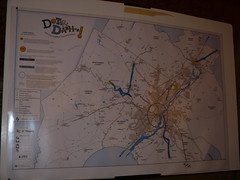
Sketching out what people want.
Preliminary Results:
Working outreach tool
Data results from two sessions have been entered into a database
Composite results (Projects people most likely prefer)
A central public game session is pending.
-----------------------------------------------
Washington State's Growth and Transportation Efficiency Centers: Keith Cotton

Growth Management Act in 1990
Commute Trip Reduction
CTR Efficiency Act 2006
CTR only addresses large employers (Employers are required to create opportunities to not drive alone)
The GTEC program...
Bringing transit to the land use table
Directs RTPOs to coordinate
Increases efficiency on the state highway system in key areas
Requires that GTECs be prioritized
-----------------------------------------------------
Transit Agency Involvement in Land Use Planning
Case Study from the Puget Sound Region
Snohomish County
Land Use Outreach
Lessons Learned
Obtained transit board endorsement of policies
New staff position dedicated to land use outreach
Approached problem from both ends
Leveraged Opportunities Created by the GMA
Emphasized coordination with local jurisdictions
No budget for facilities improvements
Connection with TDM program was informal
Outreach to the private sector was weak
Follow up with local jurisdiction infrequent
Didn't develop a robust tracking system to document program effectiveness
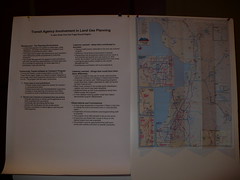
--------------------------------------------------
Where's Emeryville?
Nathan Landau of AC Transit. A dense city is basically a downtown. It doesn't have a BART station but does have Amtrak, bus connections. Emery Go Round
How does it become pedestrian friendly.
Service has been added.
Challenges
TAD vs TOD
Access cost equity
Erratic congestion
Limited potential for street/sidewalk
A new general plan
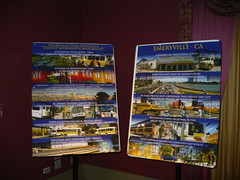
----------------------------------------------
Metrolink/Olsen Homes Partnership
Colleen Richter - Division of Marketing & Sales
JPA, made up of 5 transportation agencies
Fullerton station picture
Chasing developers for about 6 years. Olsen company is a smaller development company, intown living. Smaller urban development, live work medium to high residential density.
Objectives
Increase Core Ridership
Populate TOD
Leverage OPM
Attract Diverse Demographics
Influence Lifestyle Choices
Raise General Awareness
30% ridership is transient, changing work or jobs.
Very targeted marking but not necessarily to the general market.
The message: Life Without Traffic
Three Commuter Targets
At Work
In Traffic
On the Train
Between a 4 and 5000 dollar value for two years of metrolink service that the developer pays for.
$3.5 million in home sales. $50,000 dollars in free passes
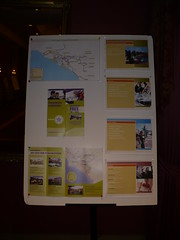
------------------------------------------
Sugarhouse Trolley
Very dense area
UTA owns the ROW
Transit and Land Use are Integrated
Unanimous Consensus to build a streetcar
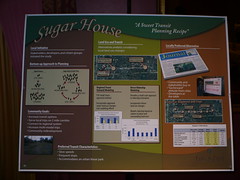
------------------------------------------
TCRP Research Urban Design and Mode Choice
What others think about where i live is as important as where I think.
Factors on mode choice
Compact Neighborhood
Values incorporated personal attitudes
Auto ownership, auto dependence, love of autos
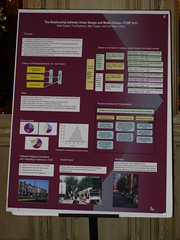
----------------------------------------------
TCRP Report 95: Jay Evans, Dick Pratt
Several Factors
Land use site design
auto ownership
parking supply
parking pricing
transit support
Self selection
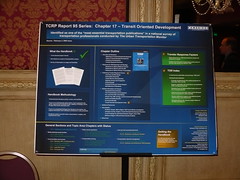
Dots and Dashes
DVRPC 7th Largest MPO in the Nation PTP Pilot Program
Set up 20 Billion dollar spending limit
How do they split their spending on the existing system, versus network expansion.

Sketching out what people want.
Preliminary Results:
Working outreach tool
Data results from two sessions have been entered into a database
Composite results (Projects people most likely prefer)
A central public game session is pending.
-----------------------------------------------
Washington State's Growth and Transportation Efficiency Centers: Keith Cotton

Growth Management Act in 1990
Commute Trip Reduction
CTR Efficiency Act 2006
CTR only addresses large employers (Employers are required to create opportunities to not drive alone)
The GTEC program...
Bringing transit to the land use table
Directs RTPOs to coordinate
Increases efficiency on the state highway system in key areas
Requires that GTECs be prioritized
-----------------------------------------------------
Transit Agency Involvement in Land Use Planning
Case Study from the Puget Sound Region
Snohomish County
Land Use Outreach
Lessons Learned
Obtained transit board endorsement of policies
New staff position dedicated to land use outreach
Approached problem from both ends
Leveraged Opportunities Created by the GMA
Emphasized coordination with local jurisdictions
No budget for facilities improvements
Connection with TDM program was informal
Outreach to the private sector was weak
Follow up with local jurisdiction infrequent
Didn't develop a robust tracking system to document program effectiveness

--------------------------------------------------
Where's Emeryville?
Nathan Landau of AC Transit. A dense city is basically a downtown. It doesn't have a BART station but does have Amtrak, bus connections. Emery Go Round
How does it become pedestrian friendly.
Service has been added.
Challenges
TAD vs TOD
Access cost equity
Erratic congestion
Limited potential for street/sidewalk
A new general plan

----------------------------------------------
Metrolink/Olsen Homes Partnership
Colleen Richter - Division of Marketing & Sales
JPA, made up of 5 transportation agencies
Fullerton station picture
Chasing developers for about 6 years. Olsen company is a smaller development company, intown living. Smaller urban development, live work medium to high residential density.
Objectives
Increase Core Ridership
Populate TOD
Leverage OPM
Attract Diverse Demographics
Influence Lifestyle Choices
Raise General Awareness
30% ridership is transient, changing work or jobs.
Very targeted marking but not necessarily to the general market.
The message: Life Without Traffic
Three Commuter Targets
At Work
In Traffic
On the Train
Between a 4 and 5000 dollar value for two years of metrolink service that the developer pays for.
$3.5 million in home sales. $50,000 dollars in free passes

------------------------------------------
Sugarhouse Trolley
Very dense area
UTA owns the ROW
Transit and Land Use are Integrated
Unanimous Consensus to build a streetcar

------------------------------------------
TCRP Research Urban Design and Mode Choice
What others think about where i live is as important as where I think.
Factors on mode choice
Compact Neighborhood
Values incorporated personal attitudes
Auto ownership, auto dependence, love of autos

----------------------------------------------
TCRP Report 95: Jay Evans, Dick Pratt
Several Factors
Land use site design
auto ownership
parking supply
parking pricing
transit support
Self selection

Subscribe to:
Posts (Atom)

